43 start with D start with D
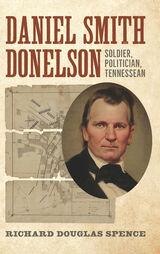
In June of 1863, Col. William P. Sanders led a cavalry raid of 1,300 men from the Union Army of the Ohio through Confederate-held East Tennessee. The raid severed the Confederate rail supply line from Virginia to the Western Theater and made national headlines. Until now, this incredible feat has been relegated to a footnote in the voluminous history of the American Civil War.
In Yankee Commandos, Stuart Brandes presents readers with the most complete account of the Sanders raid to date by using newly discovered and under-explored materials, such as Sanders’s official reports and East Tennessee diaries and memoirs in which Sanders is chronicled. The book presents important details of a cavalry raid through East Tennessee that further turned the tide of war for the Union in the Western Theater. It also sheds light on the raid’s effect on the divided civilian population of East Tennessee, where, unlike the largely pro-secession populations of Middle and West Tennessee, the fraction of enlisted men to the Union cause rose to nearly a quarter.
Colonel Sanders remains an enigma of the American Civil War. (He was a cousin of Confederate president Jefferson Davis, and his father and three brothers donned Confederate gray at the outbreak of the war.) By studying the legend of Sanders and his raid, Brandes fills an important gap in Civil War scholarship and in the story of Unionism in a mostly Confederate-sympathizing state.

—Ron Rash, author of Serena and The Cove
"The Dark Corner is one of the most riveting and beautifully written novels that I have ever read. Trouble drives the story, as it does in all great fiction, but grace, that feeling of mercy that all men hunger for, is the ultimate subject, and that's just part of the reason that Mark Powell is one of America's most brilliant writers."
—Donald Ray Pollock, author of The Devil All the Time and Knockemstiff
“Mark Powell’s third novel powerfully tackles the ongoing curses of drugs, real estate development, veterans’ plights, and other regional cultural banes that plague an Appalachia still very much alive and with us as its own chameleon-like animal. Brimming with fury and beauty, The Dark Corner is a thing wrought to be feared and admired.”
—Casey Clabough, author of Confederado
“Powell’s work is so clearly sourced to the wellspring of all spiritual understanding—this physical world…He is heir to the literary lineage of Melville, Conrad, Flannery O’Connor, Denis Johnson, and Robert Stone.”
—Pete Duval, author of Rear View
A troubled Episcopal priest and would-be activist, Malcolm Walker has failed twice over—first in an effort to shock his New England congregants out of their complacency and second in an attempt at suicide. Discharged from the hospital and haunted by images of the Iraq War and Abu Ghraib, he heads home to the mountains of northwestern South Carolina, the state’s “dark corner,” where a gathering storm of private grief and public rage awaits him.
Malcolm’s life soon converges with people as damaged in their own ways as he is: his older brother, Dallas, a onetime college football star who has made a comfortable living in real-estate development but is now being drawn ever more deeply into an extremist militia; his dying father, Elijah, still plagued by traumatic memories of Vietnam and the death of his wife; and Jordan Taylor, a young, drug-addicted woman who is being ruthlessly exploited by Dallas’s viperous business partner, Leighton Clatter. As Malcolm tries to restart his life, he enters into a relationship with Jordan that offers both of them fleeting glimpses of heaven, even as hellish realities continue to threaten them.
In The Dark Corner, Mark Powell confronts crucial issues currently shaping our culture: environmentalism and the disappearance of wild places, the crippling effects of wars past and present, drug abuse, and the rise of right-wing paranoia. With his skillful plotting, feel for place, and gift for creating complex and compelling characters, Powell evokes a world as vivid and immediate as the latest news cycle, while at the same time he offers a nuanced reflection on timeless themes of violence, longing, redemption, faith, and love.
MARK POWELL is the author of two previous novels published by the University of Tennessee Press, Prodigals and the Peter Taylor Prize–winning Blood Kin. The recipient of National Endowment for the Arts and Breadloaf Writers’ Conference fellowships, as well as the Chaffin Award for fiction, he is an assistant professor of English at Stetson University.

—Ron Rash, author of Serena and The Cove
"The Dark Corner is one of the most riveting and beautifully written novels that I have ever read. Trouble drives the story, as it does in all great fiction, but grace, that feeling of mercy that all men hunger for, is the ultimate subject, and that's just part of the reason that Mark Powell is one of America's most brilliant writers."
—Donald Ray Pollock, author of The Devil All the Time and Knockemstiff
“Mark Powell’s third novel powerfully tackles the ongoing curses of drugs, real estate development, veterans’ plights, and other regional cultural banes that plague an Appalachia still very much alive and with us as its own chameleon-like animal. Brimming with fury and beauty, The Dark Corner is a thing wrought to be feared and admired.”
—Casey Clabough, author of Confederado
“Powell’s work is so clearly sourced to the wellspring of all spiritual understanding—this physical world…He is heir to the literary lineage of Melville, Conrad, Flannery O’Connor, Denis Johnson, and Robert Stone.”
—Pete Duval, author of Rear View
A troubled Episcopal priest and would-be activist, Malcolm Walker has failed twice over—first in an effort to shock his New England congregants out of their complacency and second in an attempt at suicide. Discharged from the hospital and haunted by images of the Iraq War and Abu Ghraib, he heads home to the mountains of northwestern South Carolina, the state’s “dark corner,” where a gathering storm of private grief and public rage awaits him.
Malcolm’s life soon converges with people as damaged in their own ways as he is: his older brother, Dallas, a onetime college football star who has made a comfortable living in real-estate development but is now being drawn ever more deeply into an extremist militia; his dying father, Elijah, still plagued by traumatic memories of Vietnam and the death of his wife; and Jordan Taylor, a young, drug-addicted woman who is being ruthlessly exploited by Dallas’s viperous business partner, Leighton Clatter. As Malcolm tries to restart his life, he enters into a relationship with Jordan that offers both of them fleeting glimpses of heaven, even as hellish realities continue to threaten them.
In The Dark Corner, Mark Powell confronts crucial issues currently shaping our culture: environmentalism and the disappearance of wild places, the crippling effects of wars past and present, drug abuse, and the rise of right-wing paranoia. With his skillful plotting, feel for place, and gift for creating complex and compelling characters, Powell evokes a world as vivid and immediate as the latest news cycle, while at the same time he offers a nuanced reflection on timeless themes of violence, longing, redemption, faith, and love.
MARK POWELL is the author of two previous novels published by the University of Tennessee Press, Prodigals and the Peter Taylor Prize–winning Blood Kin. The recipient of National Endowment for the Arts and Breadloaf Writers’ Conference fellowships, as well as the Chaffin Award for fiction, he is an assistant professor of English at Stetson University.
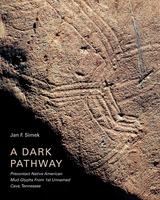
In A Dark Pathway: Precontact Native American Mud Glyphs from 1st Unnamed Cave, Tennessee, Jan Simek and his colleagues present two decades of research at a precontact dark zone cave art site in East Tennessee. Discovered in 1994, 1st Unnamed Cave ushered in an extensive and systematic effort to research precontact cave art sites in the Eastern Woodlands, where the tradition of cave art production was widespread among ancient peoples. Indeed, when a preliminary report about 1st Unnamed Cave was first published in 1997, there were only seven known cave art sites across the Southeast; today, that number exceeds ninety.
From the tale of the cave’s discovery in chapter 1 to descriptions of its art in later chapters, A Dark Pathway boasts nearly one hundred maps, high-resolution photographs, and illustrations that bring the story of one of North America’s premier cave art sites to life. Importantly, Simek and his colleagues also orient 1st Unnamed Cave within the broader context of cave art sites across the Southeast, elevating them as a whole to the notable prominence they deserve. Yet his analysis does more than present and situate the discovery of 1st Unnamed Cave within the greater realm of regional cave art site studies; it also calls for the protection and preservation of these fragile sites and for the acknowledgment of the still-vibrant indigenous cultures that produced them.
With a foreword by Russell Townsend, tribal historic preservation officer for the Eastern Band of Cherokee Indians, A Dark Pathway is a long-awaited volume more than twenty years in the making. Even as he delivers a comprehensive archaeological analysis, Simek’s clear presentation makes for accessible and thrilling reading not only for students of archaeology, anthropology, and Native American studies, but for interested readers as well.
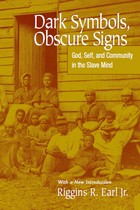
Slave owners believed Christianity would instill docility and obedience, but the slaves discovered in the Bible a different message, sharing among themselves the “dark symbols and obscure signs” that escaped the notice of their captors. Finding a sense of liberation rather than submission in their conversion experience, slaves discovered their own self-worth and their values as children of God.
Originally published in 1993, Dark Symbols, Obscure Signs traces the legacy of slaves’ embrace of Christianity both during and after the slavery era. In a new introduction, the author places the book within the context of contemporary scholarship on the roots of the African American cultural experience. He argues that any interpretation of this experience must begin with a foundational study of the theological and ethical constructs that have shaped the way blacks understand themselves in relationship to God, their oppressors, and each other.
The Author: Riggins R. Earl Jr. teaches at the Interdenominational Theological Center in Atlanta.

Copyright 1997 Reed Business Information, Inc.

Born on January 17, 1863, in Manchester, England, David Lloyd George is perhaps best known for his service as prime minister of the United Kingdom during the second half of World War I. While many biographies have chronicled his life and political endeavors, few, if any, have explored how his devotion to democratic doctrines in the Church of Christ shaped his political perspectives and choices both before and during the First World War. In David Lloyd George: The Politics of Religious Conviction, Jerry L. Gaw bridges this gap in scholarship, showcasing George’s religious roots and their impact on his politics in the late nineteenth and early twentieth centuries.
With a comprehensive narrative that spans more than a century, Gaw’s book ranges beyond typical biography and examines how the work and theology of Alexander Campbell, a founder
of the Stone-Campbell Movement in America, influenced a prominent world leader. George’s twelve diaries and the more than three thousand letters he wrote to his brother between 1886 and 1943 provide the foundation for Gaw’s thorough analysis of George’s beliefs and politics. Taken together, these texts illuminate his lifelong adherence to the Church of Christ in Britain and how his faith, in turn, contributed to his proclivity for championing humanitarian, egalitarian, and popular political policies beginning with the first of his fifty-five years in the British Parliament.
Broadly, Gaw’s study helps us to understand how the Stone-Campbell tradition—and later, Churches of Christ—became contextualized in the British Isles over the course of the nineteenth century. His significant mining of primary materials successively reveals a lesser-known side of David Lloyd George, in large part explaining how he arrived at the political decisions that helped shape history.
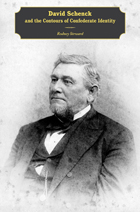
A mid-level Confederate official and lawyer in secessionist North Carolina, David Schenck (1835–1902) penned extensive diaries that have long been a wellspring of information for historians. In the midst of the secession crisis, Schenck overcame long-established social barriers and reshaped antebellum notions of manhood, religion, and respectability into the image of a Confederate nationalist. He helped found the revolutionary States’ Rights Party and relentlessly pursued his vision of an idealized Southern society even after the collapse of the Confederacy. In the first biography of this complicated figure, Rodney Steward opens a window into the heart and soul of the Confederate South’s burgeoning professional middle class and reveals the complex set of desires, aspirations, and motivations that inspired men like Schenck to cast for themselves a Confederate identity that would endure the trials of war, the hardship of Reconstruction, and the birth of a New South.
After secession, Schenck remained on the home front as a receiver under the Act of Sequestration, enriching himself on the confiscated property of those he accused of disloyalty. After the war, his position as a leader in the Ku Klux Klan and his resistance to Radical Reconstruction policies won him a seat on the superior court bench, but scathing newspaper articles about his past upended a bid for chief justice of the North Carolina Supreme Court, a compelling fall from grace that reveals much about the shifting currents in North Carolina society and politics in the years after Reconstruction. During the last twenty years of his life, spent in Greensboro, Schenck created the Guilford Battleground Company in an effort to redeem the honor of the Tar Heels who fought there and his own honor as well.
Schenck’s life story provides a powerful new lens to examine and challenge widely held interpretations of secessionists, Confederate identity, Civil War economics, and home-front policies. Far more than a standard biography, this compelling volume challenges the historiography of the Confederacy at many levels and offers a sophisticated analysis of the evolution of a Confederate identity over a half century.
Rodney Steward is an assistant professor of history at the University of South Carolina, Salkehatchie. His works have appeared in the Virginia Magazine of History and Biography, Encyclopedia of North Carolina, and North Carolina Historical Review.
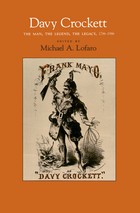

In this guide, Molloy leads readers through forty hikes within the natural wonders of DBNF, including Natural Bridge and Cumberland Falls. Descriptions of each hike are straightforward and accurate, so readers can focus on enjoying natural features, scenic overlooks, interesting geological formations, and landmarks along the trails. Hikers will see the best of the Cumberland Plateau, from exquisite arches to bluffs that offer extensive vistas to waterfalls that descend into sandstone cathedrals. The paths tread through deep forests in gorges cut by creeks and rivers and atop the Cumberland Plateau, where oak and pine forests range long distances. Rockhouses, caves, and other geological features stand out in these rich woodlands. Hikers may also encounter protected plants and animals along these trails, including the red-cockaded woodpecker, Virginia big-eared bat, freshwater mussels, white-haired goldenrod, and the black bear.
Detailed, easy-to-follow directions for each trail will allow hikers to progress on their chosen course without frustrating detours. The hikes range in distance, difficulty, and destination, offering the full breadth of hiking experiences to be had within the DBNF. The shortest hike is under a mile, and the longest is ten, with most somewhere in the middle. Hikers can use the chart at beginning of the book to select the perfect trail for their experience level and desires. Also included are detailed trail maps and photos.
For the new hiker as well as the experienced outdoor adventurer, Day Hiking Kentucky’s Daniel Boone National Forest is sure to become an indispensable guide to one of Kentucky’s national treasures.
Johnny Molloy has published more than sixty books about hiking and other forms of outdoor adventure, including Trial by Trail: Backpacking in the Smoky Mountains, second edition, and Mount Rogers National Recreation Area Guidebook: A Complete Resource for Outdoor Enthusiasts, third edition.
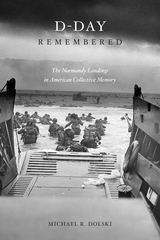
D-Day, the Allied invasion of northwestern France in June 1944, has remained in the forefront of American memories of the Second World War to this day. Depictions in books, news stories, documentaries, museums, monuments, memorial celebrations, speeches, games, and Hollywood spectaculars have overwhelmingly romanticized the assault as an event in which citizen-soldiers—the everyday heroes of democracy—engaged evil foes in a decisive clash fought for liberty, national redemption, and world salvation.
In D-Day Remembered, Michael R. Dolski explores the evolution of American D-Day tales over the course of the past seven decades. He shows the ways in which that particular episode came to overshadow so many others in portraying the twentieth century’s most devastating cataclysm as “the Good War.” With depth and insight, he analyzes how depictions in various media, such as the popular histories of Stephen Ambrose and films like The Longest Day and Saving Private Ryan, have time and again reaffirmed cherished American notions of democracy, fair play, moral order, and the militant, yet non-militaristic, use of power for divinely sanctioned purposes. Only during the Vietnam era, when Americans had to confront an especially stark challenge to their pietistic sense of nationhood, did memories of D-Day momentarily fade. They soon reemerged, however, as the country sought to move beyond the lamentable conflict in Southeast Asia.
Even as portrayals of D-Day have gone from sanitized early versions to more realistic acknowledgments of tactical mistakes and the horrific costs of the battle, the overarching story continues to be, for many, a powerful reminder of moral rectitude, military skill, and world mission. While the time to historicize this morality tale more fully and honestly has long since come, Dolski observes, the lingering positive connotations of D-Day indicate that the story is not yet finished.

The Battle of Antietam has long been known as the bloodiest day in American military history with more than twenty thousand soldiers either dead, wounded, or missing. The Confederacy, emboldened after a conclusive victory at the Battle of Second Manassas, launched the Maryland Campaign and considered a decisive battle on northern soil as a lynchpin to their objectives. As Gen. Robert E. Lee pushed his veteran Army of Northern Virginia deeper into Maryland, Gen. George B. McClellan hastily assembled a refurbished Army of the Potomac. After engagements at South Mountain and Harpers Ferry, Lee concentrated his forces near the small village of Sharpsburg. On September 17, 1862, McClellan attacked at dawn, igniting a battle that raged until sunset. By the end of the following day, Lee’s battered army began its withdrawal. The eventual Confederate retreat provided the Lincoln Administration a much sought after victory. President Lincoln announced the Emancipation Proclamation just four days later, dramatically altering the very nature of the war.
Decisions at Antietam introduces readers to critical decisions made by Confederate and Union commanders throughout the battle. Michael S. Lang examines the decisions that prefigured the action and shaped the contest as it unfolded. Rather than a linear history of the battle, Lang’s discussion of the critical decisions presents readers with a vivid blueprint of the battle’s developments. Exploring the critical decisions in this way allows the reader to progress from a sense of what happened in these battles to why they happened as they did
Complete with maps and a guided tour, Decisions at Antietam is an indispensable primer, and readers looking for a concise introduction to the battle can tour this sacred ground—or read about it at their leisure—with key insights into the battle and a deeper understanding of the Civil War itself.
Decisions at Antietam is the ninth in a series of books that will explore the critical decisions of major campaigns and battles of the Civil War.
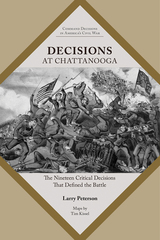
Decisions at Chattanooga introduces readers to critical decisions made by Confederate and Union commanders. Larry Peterson examines the decisions that shaped the way both campaign and battle unfolded. Rather than offering a history of the Battle of Chattanooga, Peterson focuses on the critical decisions, presenting the reader with a coherent and manageable blueprint of the battle’s development. Exploring and studying the critical decisions allows the reader to progress from an understanding of what happened to why events happened as they did.
Complete with maps and a guided tour, Decisions at Chattanooga is an indispensable primer, and readers looking for a digestible introduction to the Battle of Chattanooga can tour this sacred ground—or read about it at their leisure—with key insights into the campaign and a deeper understanding of the Civil War itself.
Decisions at Chattanooga is the fourth in a series of books that will explore the critical decisions of major campaigns and battles of the Civil War.
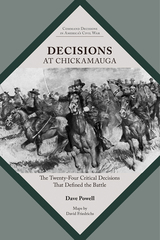
Decisions at Chickamauga introduces readers to critical decisions made by Confederate and Union commanders during that fateful battle. Rather than offering a history of the Battle of Chickamauga, Powell focuses on critical decisions as they developed. This account is designed to present the reader with a coherent and manageable interpretive blueprint of the battle’s key moments. Exploring and studying these critical decisions allows the reader to progress from an understanding of what happened to why events happened as they did.
Complete with maps and a guided tour, Decisions at Chickamauga will be an indispensable primer, and readers looking for a digestible introduction to the Battle of Chickamauga can tour this sacred ground—or read about it at their leisure—and gain key insights into why events unfolded as they did as well as a deeper understanding of the Civil War itself.
Decisions at Chickamauga is the third in a series of books that will explore the critical decisions of major campaigns and battles of the Civil War.
DAVE POWELL is the author of five books on the Battle of Chickamauga, including the three-volume The Chickamauga Campaign. His articles have appeared in North & South Magazine, Gettysburg Magazine, and Civil War History, among others.

Decisions at Forts Henry and Donelson explores the critical decisions made by Confederate and Federal commanders during the battle and how these decisions shaped its outcome. Rather than offering a history of the battle, Hank Koopman hones in on a sequence of critical decisions made by commanders on both sides of the conflict to provide a blueprint of the Battles of Forts Henry and Donelson at their tactical core. Identifying and exploring the critical decisions in this way allows students of the battles to progress from a knowledge of what happened to a mature grasp of why events happened.
Complete with maps and a driving tour, Decisions at Forts Henry and Donelson is an indispensable primer, and readers looking for a concise introduction to these battles can tour this sacred ground—or read about it at their leisure—with key insights into the campaigns and a deeper understanding of the Civil War itself.
Decisions at Forts Henry and Donelson is the eighteenth in a series of books that will explore the critical decisions of major campaigns and battles of the Civil War.
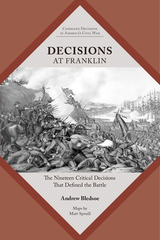
Decisions at Franklin explores the critical decisions made by Confederate and Union commanders during the battle and how these decisions shaped its outcome. Rather than offering a history of the battle, Andrew Bledsoe hones in on a sequence of critical decisions made by commanders on both sides of the contest to provide a blueprint of the Battle of Franklin at its tactical core. Identifying and exploring the critical decisions in this way allows students of the battle to progress from a knowledge of what happened to a deep understanding of why events
happened.
Complete with maps and a driving tour, Decisions at Franklin is an indispensable primer, and readers looking for a concise introduction to the battle can tour this sacred ground—or read about it at their leisure—with key insights into the campaign and a greater understanding of the Civil War itself.
Decisions at Franklin is the fifteenth in a series of books that will explore the critical decisions of major campaigns and battles of the Civil War.
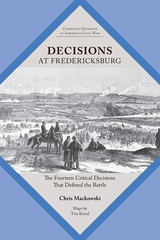
In the fall of 1862, after a leadership shake-up initiated by Lincoln, Gen. Ambrose Burnside assumed command of the Army of the Potomac and developed an aggressive plan to attack the Confederate capital of Richmond. However, in order to reach Richmond, Burnside had to march through Fredericksburg, where Gen. Robert E. Lee’s Army of Northern Virginia was well entrenched. After crossing the Rappahannock River under enemy fire, Burnside and his troops engaged Lee’s army within the city, then launched a futile frontal assault against a heavily fortified ridge west of Fredericksburg. The end result was a decisive victory for the Confederacy, as the Union army suffered more than double the number of casualties as its foes. Burnside would resign a month later but would resurface as war in the Western Theater grew heated.
Decisions at Fredericksburg explores the critical decisions made by Confederate and Union commanders during the battle and how these decisions shaped its outcome. Rather than offering a history of the battle, Chris Mackowski hones in on a sequence of critical decisions made by commanders on both sides of the contest to provide a blueprint of the Battle of Fredericksburg at its tactical core. Identifying and exploring the critical decisions in this way allows students of the battle to progress from knowledge of what happened to a mature grasp of why events happened.
Complete with maps and a driving tour, Decisions at Fredericksburg is an indispensable primer, and readers looking for a concise introduction to the battle can tour this sacred ground—or read about it at their leisure—with key insights into the campaign and a deeper understanding of the Civil War itself.
Decisions at Fredericksburg is the eleventh in a series of books that will explore the critical decisions of major campaigns and battles of the Civil War.
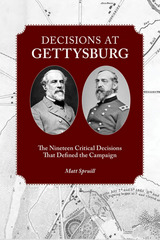
The Campaign and Battle of Gettysburg have inspired scrutiny from virtually every angle. Standing out amid the voluminous scholarship, this book is not merely one more narrative history of the events that transpired before, during, and after those three momentous July days in southern Pennsylvania. Rather, it focuses on and analyzes nineteen critical decisions by Union and Confederate commanders that determined the particular ways in which those events unfolded.
Matt Spruill, a retired U.S. Army colonel who studied and taught at the U. S. Army War College in Carlisle, Pennsylvania, contends that, among the many decisions made during any military campaign, a limited number—strategic, operational, tactical, organizational—make the difference, with subsequent decisions and circumstances proceeding from those defining moments. At Gettysburg, he contends, had any of the nineteen decisions he identifies not been made and/or another decision made in its stead, all sorts of events from those decision points on would have been different and the campaign and battle as we know it today would appear differently. The battle might have lasted two days or four days instead of three. The orientation of opposing forces might have been different. The battle could well have occurred away from Gettysburg rather than around the town. Whether Lee would have emerged the victor and Meade the vanquished remains an open question, but whatever the outcome, it was the particular decision-making delineated here that shaped the campaign that went into the history books.
Along with his insightful analysis of the nineteen decisions, Spruill includes a valuable appendix that takes the battlefield visitor to the actual locations where the decisions were made or executed. This guide features excerpts from primary documents that further illuminate the ways in which the commanders saw situations on the ground and made their decisions accordingly.
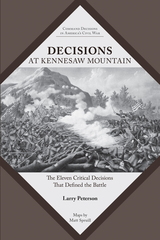
Decisions at Kennesaw Mountain explores the critical decisions made by Confederate and Federal commanders during the battle and how these decisions shaped its outcome. Rather than offering a history of the battle, Larry Peterson hones in on a sequence of command decisions that provides us, retroactively, with a blueprint of the Battle of Kennesaw Mountain at its tactical core. Identifying and exploring the critical decisions in this way allows students of the battle to progress from a knowledge of what happened to a mature grasp of why events happened.
Complete with maps and a driving tour, Decisions at Kennesaw Mountain is an indispensable primer, and readers looking for a concise introduction to the battle can tour this sacred ground—or read about it at their leisure—with key insights into the campaign and a deeper understanding of the Civil War itself.
Decisions at Kennesaw Mountain is the seventeenth in a series of books that will explore the critical decisions of major campaigns and battles of the Civil War.
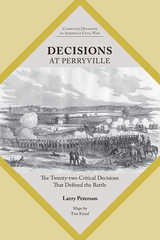
The largest battle fought in Kentucky during the American Civil War occurred at a small, crossroads town named Perryville. As Gen. Braxton Bragg’s Confederate Heartland Offensive sputtered through Kentucky, Maj. Gen. Don Carlos Buell’s reformed Army of the Ohio pursued the Army of the Mississippi and clashed with its rearguard just outside Perryville. Believing that he faced only a part of Buell’s army, Bragg ordered an assault on the Union left flank which resulted in Confederate victory. However, that evening Bragg determined the Army of the Ohio outnumbered him three to one and quickly decided to retreat. Outmanned, outmaneuvered, and lacking supplies and reinforcements, Bragg retreated through the Cumberland Gap into East Tennessee, and Kentucky remained in Union control for the rest of the Civil War.
Decisions at Perryville explores the critical decisions made by Confederate and Union commanders during the battle and how these decisions shaped its outcome. Rather than offering a history of the battle, Larry Peterson hones in on a sequence of critical decisions made by commanders on both sides of the contest to provide a blueprint of the Battle of Perryville at its tactical core. Identifying and exploring the critical decisions in this way allows students of the battle to progress from a knowledge of what happened to a mature grasp of why events happened.
Complete with maps and a driving tour, Decisions at Perryville is an indispensable primer, and readers looking for a concise introduction to the battle can tour this sacred ground—or read about it at their leisure—with key insights into the campaign and a deeper understanding of the Civil War itself.
Decisions at Perryville is the eleventh in a series of books that will explore the critical decisions of major campaigns and battles of the Civil War.
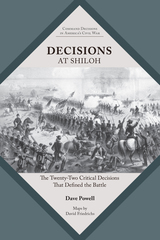
The Battle of Shiloh took place April 6–7, 1862, between the Union Army of the Tennessee under General Ulysses S. Grant and the Confederate Army of Mississippi under General Albert Sidney Johnston. Johnston launched a surprise attack on Grant but was mortally wounded during the battle. General P. G. T. Beauregard, taking over command, chose not to press the attack through the night, and Grant, reinforced with troops from the Army of the Ohio, counterattacked the morning of April 7th and turned the tide of the battle.
Decisions at Shiloh introduces readers to critical decisions made by Confederate and Union commanders throughout the battle. Dave Powell examines the decisions that prefigured the action and shaped the contest as it unfolded. Rather than a linear history of the battle, Powell’s discussion of the critical decisions presents readers with a vivid blueprint of the battle’s developments. Exploring the critical decisions in this way allows the reader to progress from a sense of what happened in these battles to why they happened as they did
Complete with maps and a guided tour, Decisions at Shiloh is an indispensable primer, and readers looking for a concise introduction to the battle can tour this sacred ground—or read about it at their leisure—with key insights into the battle and a deeper understanding of the Civil War itself.
Decisions at Shiloh is Powell’s second contribution and the fourteenth in a series of books that will explore the critical decisions of major campaigns and battles of the Civil War.
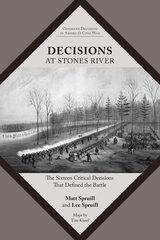
From December 31, 1862, to January 2, 1863, the Army of the Cumberland and Army of Tennessee fought a bloody battle along Stones River. Led by Major General William S. Rosecrans, Union forces would eventually emerge victorious. Coming at the end of a series of Union defeats, this victory would give Lincoln and the Northern population a bright ray of hope during a fall and winter of reversals.
Decisions at Stones River introduces readers to critical decisions made by Confederate and Union commanders. Matt Spruill and Lee Spruill examine the decisions that shaped the way the campaign and battle unfolded. Rather than offering a history of the Battle of Stones River, the Spruills focus on the critical decisions, those decisions that had a major impact on both Federal and Confederate forces in shaping the progression of the battle as we know it today. This account is designed to present the reader with a coherent and manageable blueprint of the battle’s development. Exploring and studying the critical decisions allows the reader to progress from an understanding of “what happened” to “why events happened” as they did.
Complete with maps and a guided tour, Decisions at Stones River is an indispensable primer, and readers looking for a digestible introduction to the Battle of Stones River can tour this sacred ground—or read about it at their leisure—with key insights into why events unfolded as they did and a deeper understanding of the Civil War itself.
Decisions at Stones River is the first in a series of books that will explore the critical decisions of major campaigns and battles of the Civil War
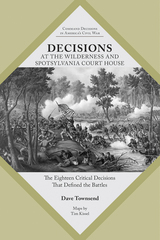
The successive battles of The Wilderness and Spotsylvania Court House opened Lt. Gen. Ulysses S. Grant’s 1864 Overland Campaign. As the first confrontation between Union and Confederate leaders Grant and Gen. Robert E. Lee, these two bloody battles signaled the new reality of war. The fighting at the Battle of The Wilderness, immediately followed by the Battle of Spotsylvania Court House, was costly for both sides, and while the Union army could replace its losses, Lee’s Army of Northern Virginia could not. It would be exactly one year from Grant’s orders to Gen. George G. Meade stating that Lee’s army would be his objective until the surrender at Appomattox.
Decisions at The Wilderness and Spotsylvania Court House introduces readers to critical decisions made by Confederate and Union commanders throughout the two costly meetings. Dave Townsend examines the decisions that prefigured the action and shaped the course of each battle as it unfolded. Rather than a linear history of the battles, Townsend’s discussion of the critical decisions presents readers with a vivid blueprint of the battles’ developments. Exploring the critical decisions in this way allows the reader to progress from a sense of what happened in these battles to why they happened as they did.
Complete with maps and a guided tour, Decisions at The Wilderness and Spotsylvania Court House is an indispensable primer, and readers looking for concise introductions to the battles can tour this sacred ground—or read about it at their leisure—with key insights into the battles and a deeper understanding of the Civil War itself.
Decisions at The Wilderness and Spotsylvania Court House is the seventh in a series of books that will explore the critical decisions of major campaigns and battles of the Civil War.
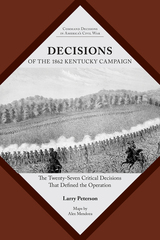
Decisions of the 1862 Kentucky Campaign introduces readers to critical decisions made by Confederate and Union commanders throughout the heartland contest. Rather than offering a history of the Kentucky Campaign, Larry Peterson hones in on a sequence of critical decisions confronting commanders on both sides of the clash to provide a blueprint of the campaign at its tactical core. Identifying and exploring the critical decisions in this way allows students of history to go from a rudimentary sense of the what of warfare, to a mature grasp of why.
Complete with maps and a guided tour, Decisions of the 1862 Kentucky Campaign is an indispensable primer, and readers looking for a digestible introduction to the campaign’s battles can tour this sacred ground—or read about it at their leisure—with key insights into the campaign and a deeper understanding of the Civil War itself.
Decisions of the 1862 Kentucky Campaign is the sixth in a series of books that will explore the critical decisions of major campaigns and battles of the Civil War.
LARRY PETERSON retired from United Airlines as a Boeing 757/767 Standard Captain. He is the author of Confederate Combat Commander: The Remarkable Life of Brigadier General Alfred Jefferson Vaughn Jr. and Decisions at Chattanooga.
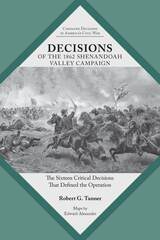
Decisions of the 1862 Shenandoah Valley Campaign explores the critical decisions made by Confederate and Union commanders during the battle and how these decisions shaped its outcome. Rather than offering a history of the battle, Robert G. Tanner hones in on a sequence of critical decisions made by commanders on both sides of the contest to provide a blueprint of Jackson’s Valley Campaign at its tactical core. Identifying and exploring the critical decisions in this way allows students of the battle to progress from a knowledge of what happened to a mature grasp of why events happened.
Complete with maps and a driving tour, Decisions of the 1862 Shenandoah Valley Campaign is an indispensable primer, and readers looking for a concise introduction to the battle can tour this sacred ground—or read about it at their leisure—with key insights into the campaign and a deeper understanding of the Civil War itself.
Decisions of the 1862 Shenandoah Valley Campaign is the seventeenth in a series of books that will explore the critical decisions of major campaigns and battles of the Civil War.
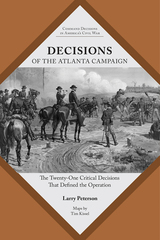
Decisions of the Atlanta Campaign introduces readers to critical decisions made by Confederate and Union commanders throughout that tide-turning summer of 1864. Rather than offering a history of the Atlanta Campaign, Larry Peterson hones in on a sequence of critical decisions confronting commanders on both sides of the clash to provide a blueprint of the campaign at its tactical core. Identifying and exploring the critical decisions in this way allows students of the campaign to progress from a rudimentary sense of the what of warfare, to a mature grasp of why.
Complete with maps and a guided tour, Decisions of the Atlanta Campaign is an indispensable primer, and readers looking for a digestible introduction to the Battle of Chattanooga can tour this sacred ground—or read about it at their leisure—with key insights into the campaign and a deeper understanding of the Civil War itself.
Decisions of the Atlanta Campaign is the fifth in a series of books that will explore the critical decisions of major campaigns and battles of the Civil War.
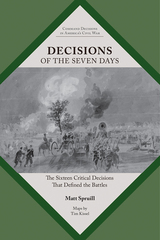
From June 25 to July 1, 1862, Gen. Robert E. Lee’s Army of Northern Virginia engaged Maj. Gen. George B. McClellan’s Army of the Potomac in a series of battles at the end of the Peninsula Campaign that would collectively become known as the Seven Days Battles. Beginning with the fighting at the Battle of Beaver Dam Creek, Lee consistently maneuvered against and attacked McClellan’s Army of the Potomac as it retreated south across the Virginia Peninsula to the James River. At the conclusion of the Battle of Malvern Hill, Lee’s second most costly battle, where McClellan’s strong defensive position of infantry and artillery repelled multiple frontal assaults by Lee’s troops, the Federal army slipped from Lee’s grasp and brought the Seven Days to an end. The Seven Days was a clear Confederate victory that drove the Union army away from the capital at Richmond, began the ascendancy of Robert E. Lee, and commenced a change in the war in the Eastern Theater. It set the stage for the Second Manassas Campaign followed by the Maryland Campaign of 1862.
Decisions of the Seven Days explores the critical decisions made by Confederate and Union commanders during the Seven Days Battles and how these decisions shaped the outcome. Rather than offering a history of the battles, Matt Spruill hones in on a sequence of critical decisions made by commanders on both sides of the contests to provide a blueprint of the Seven Days at its tactical core. Identifying and exploring the critical decisions in this way allows students of the battles to progress from knowledge of what happened to a mature grasp of why events happened.
Complete with maps and a driving tour, Decisions of the Seven Days is an indispensable primer, and readers looking for a concise introduction to the battles can tour this sacred ground—or read about it at their leisure—with key insights into the campaign and a deeper understanding of the Civil War itself.
Decisions of the Seven Days is the tenth in a series of books that will explore the critical decisions of major campaigns and battles of the Civil War.
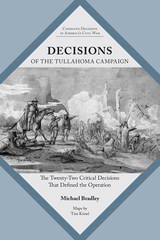
The Tullahoma Campaign took place in Middle Tennessee, setting Union General William S. Rosecrans’s Army of the Cumberland against Confederate General Braxton Bragg’s Army of Tennessee. Rosecrans’s objective was to force the Confederate Army to vacate Middle Tennessee and put pressure on Chattanooga. Through a series of maneuvers, rather than battles, he achieved his goal; however, Union victories at Vicksburg and Gettysburg would overshadow his success.
Decisions of the Tullahoma Campaign introduces readers to critical decisions made by Confederate and Union commanders throughout that eventful summer of 1863. Rather than offering a history of the Tullahoma Campaign, Michael R. Bradley hones in on a sequence of critical decisions confronting commanders on both sides of the clash to provide a blueprint of the campaign at its tactical core. Identifying and exploring the critical decisions in this way allows students of the campaign to progress from a rudimentary sense of the what of warfare, to a mature grasp of why.
Complete with maps and a driving tour, Decisions of the Tullahoma Campaign is an indispensable primer, and readers looking for a concise introduction to the Tullahoma Campaign can tour this sacred ground—or read about it at their leisure—with key insights into the campaign and a deeper understanding of the Civil War itself.
Decisions of the Tullahoma Campaign is the eighth in a series of books that will explore the critical decisions of major campaigns and battles of the Civil War.
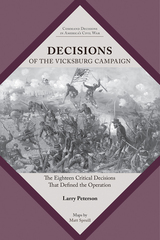
Decisions of the Vicksburg Campaign explores the critical decisions made by Confederate and Federal commanders during the battle and how these decisions shaped its outcome. Rather than offering a history of the battle, Larry Peterson hones in on a sequence of critical decisions made by commanders on both sides of the contest to provide a blueprint of the battles for Vicksburg at their tactical core. Identifying and exploring the critical decisions in this way allows students of the battles to progress from a knowledge of what happened to a mature grasp of why events unfolded as they did.
Complete with maps and a driving tour, Decisions of the Vicksburg Campaign is an indispensable primer, and readers looking for a concise introduction to the battle can tour this sacred ground—or read about it at their leisure—with key insights into the campaign and a deeper understanding of the Civil War itself. Decisions of the Vicksburg Campaign is the twentieth in a series of books that will explore the critical decisions of major campaigns and battles of the Civil War.
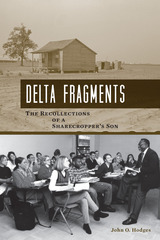
Hodges has structured the book as a series of brief but revealing vignettes grouped into two main sections. In part 1, “Learning,” he introduces us to the town of Greenwood and to his parents, sister, and myriad aunts, uncles, cousins, teachers, and schoolmates. He tells stories of growing up on a plantation, dancing in smoky juke joints, playing sandlot football and baseball, journeying to the West Coast as a nineteen-year-old to meet the biological father he never knew while growing up, and leaving family and friends to attend Morehouse College in Atlanta. In part 2, “Reflecting,” he connects his firsthand experience with broader themes: the civil rights movement, Delta blues, black folkways, gambling in Mississippi, the vital role of religion in the African American community, and the perplexing problems of poverty, crime, and an underfunded educational system that still challenge black and white citizens of the Delta.
Whether recalling the assassination of Medgar Evers (whom he knew personally), the dynamism of an African American church service, or the joys of reconnecting with old friends at a biennial class reunion, Hodges writes with a rare combination of humor, compassion, and—when describing the injustices that were all too frequently inflicted on him and his contemporaries—righteous anger. But his ultimate goal, he contends, is not to close doors but to open them: to inspire dialogue, to start a conversation, “to be provocative without being insistent or definitive.”
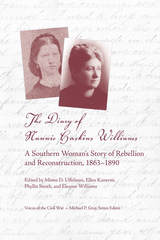
and family as Nannie, began a diary. The Diary of Nannie Haskins Williams: A Southern
Woman’s Story of Rebellion and Reconstruction, 1863–1890 provides valuable insights into
the conditions in occupied Middle Tennessee. A young, elite Confederate sympathizer,
Nannie was on the cusp of adulthood with the expectation of becoming a mistress in
a slaveholding society. The war ended this prospect, and her life was forever changed.
Though this is the first time the diaries have been published in full, they are well known
among Civil War scholars, and a voice-over from the wartime diary was used repeatedly
in Ken Burns’s famous PBS program The Civil War.
Sixteen-year-old Nannie had to come to terms with Union occupation very early in
the war. Amid school assignments, young friendship, social events, worries about her
marital prospects, and tension with her mother, Nannie’s entries also mixed information
about battles, neighbors wounded in combat, U.S. Colored troops, and lawlessness in the
surrounding countryside. Providing rare detail about daily life in an occupied city, Nannie’s
diary poignantly recounts how she and those around her continued to fight long after
the war was over—not in battles, but to maintain their lives in a war-torn community.
Though numerous women’s Civil War diaries exist, Nannie’s is unique in that she also
recounts her postwar life and the unexpected financial struggles she and her family experienced
in the post-Reconstruction South. Nannie’s diary may record only one woman’s
experience, but she represents a generation of young women born into a society based
on slavery but who faced mature adulthood in an entirely new world of decreasing farm
values, increasing industrialization, and young women entering the workforce. Civil War
scholars and students alike will learn much from this firsthand account of coming-of-age
during the Civil War.
Minoa D. Uffelman is an associate professor of history at Austin Peay State University.
Ellen Kanervo is professor emerita of communications at Austin Peay State University.
Phyllis Smith is retired from the U.S. Army and currently teaches high school science in
Montgomery County, Tennessee. Eleanor Williams is the Montgomery County, Tennessee,
historian.
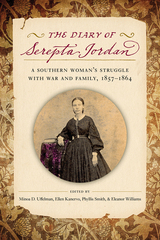
Discovered in a smokehouse in the mid-1980s, the diary of Serepta Jordan provides a unique window into the lives of Confederates living in occupied territory in upper middle Tennessee. A massive tome, written in a sturdy store ledger, the diary records every day from the fall of 1857 to June 1864. In this abridged version, Jordan reports local news, descriptions of her daily activities, war news, and social life. Orphaned at twelve, Jordan—her first name shortened to “Rep” by family and friends—lived in bustling New Providence (now part of Clarksville), Tennessee, on the banks of the Red River. Well educated by private tutors, Jordan read widely, followed politics, and was a skilled seamstress interested in the latest fashions.
Jordan’s descendants worked tirelessly toward ensuring the publication of this diary. In its carefully annotated pages, readers will learn about the years of sectional conflict leading up to the war, the diarist’s dizzying array of daily activities, and her attitudes toward those she encountered. Jordan takes a caustic tone toward Union occupiers, whom she accused of “prancing round on their fine horses.” She routinely refers to the USA as “Lincolndom” and describes her contempt toward the African Americans in the blue uniforms of the Union army. She seems to have also harbored a bitter resentment toward the “elites” on the other side of the river in Clarksville. This one-of-a-kind volume not only adds a distinct female voice to the story of the Civil War, but also a unique new picture of the slow but steady disintegration of the “peculiar institution” of slavery.
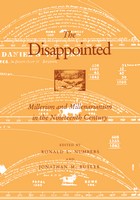
The millennial myth in Amercan life, as manifested in Millerism, has proven so resilient that some scholars have come to consider it central to the nation's self-understanding. The 1984 conference on "Millerism and the Millenarian Mind in 19th Century America," from which this volume resulted, marked a new direction in Millerite studies, bringing together for the first time both Adventist and non-Adventist scholars interested in critically evaluating the Millerite experience and its place in American history.

Until its reissue in 1988 with the help of renowned southern culture scholar John Egerton, Dishes and Beverages of the Old South lingered as a rare text on southern foodways. Now, in its third edition, and with a new foreword by Sheri Castle, this pathfinding cookbook—one of the first to be written in a narrative style—is available to a new generation of southern foodies and amateur chefs. McCulloch-Williams not only provides recipes for the modern cook, but she expounds upon the importance of quality ingredients, muses on memories brought back by a good meal, and deftly recognizes that comfort goes hand in hand with southern eats. Castle navigates the third edition of Dishes and Beverages of the Old South with a clear vision of McCulloch-Williams and her southern opus, and readers and cooks alike will be invigorated by the republication of this classic work.
SHERI CASTLE is a food writer and author of three cookbooks on southern food, including The Southern Living Community Cookbook, which was a finalist for the IACP Cookbook Award.

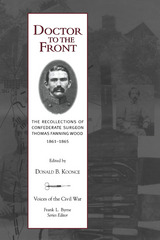
The Civil War was a tragic conflict that destroyed many lives, but for those trying to save lives the tragedy was often compounded. Military doctors labored through the smoke of battle where impossible conditions and fear of infection often forced them to resort to amputation, and most operations were performed without painkillers. Thomas Fanning Wood recorded his wartime experiences as a Confederate Army surgeon, and his recollections of those events allow us to hear a distinct voice of the Civil War.
As a young soldier recovering from fever at a Richmond hospital, Wood developed an interest in medicine that was encouraged by a doctor who steered him toward medical training. After only eight months of study he was made an assistant surgeon in the Third North Carolina Regiment. His narrative—drawn from his memoirs, letters from the front, and articles written for his hometown newspaper—presents a poignant and sometimes horrifying picture of what the Civil War physician had to face both under battlefield conditions and in urban hospitals.
Wood himself spent much of his time at the front, and his vivid narrative describes both a doctor’s daily activities and the campaigns he witnessed. He was present at many of the war’s major engagements: he was near Stonewall Jackson when the general fell at Chancellorsville, manned a field dressing station at the foot of Culp’s Hill at Gettysburg, and was one of the few survivors of the Union attack on the "mule shoe" at Spotsylvania when his entire division was wiped out. Wood’s account also lends new insight into Jubal Early’s 1864 campaigns in the Shenandoah Valley and against Washington.
With its observations of medical care and training not found in standard histories of the war—including a description of the examination required to become an assistant surgeon—Doctor to the Front offers a unique human perspective on the Civil War. With their additional descriptions of key figures and events, Wood’s recollections combine historical significance and human interest to show us another side of that terrible conflict.
The Author: Donald B. Koonce is the great-grandson of Thomas Fanning Wood and has served on the Board of Directors of the South Carolina Historical Society and the Historic Greenville Foundation. He is president of the Koonce Group, Inc., an award-winning communications company whose productions include Daybreak at the Cowpens, a documentary for the National Park Service.
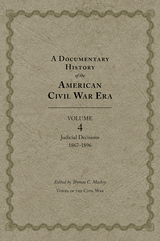
of public policy actions, political speeches, and judicial decisions related to the American
Civil War. Collectively, the four volumes in this series give scholars, teachers, and students
easy access to the full texts of the most important, fundamental documents as well as hardto-
find, rarely published primary sources on this critical period in U.S. history.
The first two volumes of the series, Legislative Achievements and Political Arguments,
were released last year. The final installment, Judicial Decisions, is divided into two volumes.
The first volume, spanning the years 1857 to 1866, was released last year. This second
volume of Judicial Decisions covers the years 1867 to 1896. Included here are some of
the classic judicial decisions of this time such as the 1869 decision in Texas v. White and
the first judicial interpretation of the 1868 Fourteenth Amendment, the 1873 Slaughter-
House Cases. Other decisions are well known to specialists but deserve wider readership
and discussion, such as the 1867 state and 1878 federal cases that upheld the separation of
the races in public accommodations (and thus constituted the common law of common
commerce) long before the more notorious 1896 case of Plessy v. Ferguson (also included).
These judicial voices constitute a lasting and often overlooked aspect of the age of Abraham
Lincoln. Mackey’s headnotes and introductory essays situate cases within their historical
context and trace their lasting significance. In contrast to decisions handed down
during the war, these judicial decisions lasted well past their immediate political and legal
moment and deserve continued scholarship and scrutiny.
This document collection presents the raw “stuff” of the Civil War era so that students,
scholars, and interested readers can measure and gauge how that generation met Lincoln’s
challenge to “think anew, and act anew.” A Documentary History of the American Civil
War Era is an essential acquisition for academic and public libraries in addition to being a
valuable resource for courses on the Civil War and Reconstruction, legal history, political
history, and nineteenth-century American history.
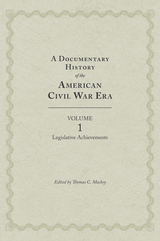
The first volume of the series, Legislative Achievements, contains legislation passed in response to the turmoil seizing the country on the brink of, during, and in the wake of the Civil War. Forthcoming are volume 2, Political Arguments, which contains voices of politicians, political party platforms, and administrative speeches, and volume 3, Judicial Decisions, which provides judicial opinions and decisions as the Civil War raged in the courtrooms as well as on the battlefields.
Organized chronologically, each of the selections is preceded by an introductory headnote that explains the document’s historical significance and traces its lasting impact. These headnotes provide insight into not only law and public policy but also the broad sweep of issues that engaged Civil War–era America.
Legislative Achievements features some of the most momentous and enduring public policy documents from the time, beginning with the controversial September 15, 1850, Fugitive Slave Act and concluding with the June 18, 1878, Posse Comitatus Act. Both military and nonmilitary legislation constitute this part, including the April 19, 1861, proclamation by President Abraham Lincoln declaring a naval blockade on Southern ports and Confederate President Jefferson Davis’s proclamation authorizing blockade runners to attack Northern shipping, both issued on the same day. Nonmilitary legislation includes statutes affecting the postwar period, such as the 1862 Homestead Act, the Civil Rights Act of 1866, and all four of the Reconstruction Acts. Also in this section are the three constitutional amendments, the Habeas Corpus Acts of 1863 and 1867, the Freedman’s Bureau Acts of 1865 and 1866, and the 1867 Tenure of Office Act together with President Andrew Johnson’s message vetoing the Act.
A Documentary History of the American Civil War Era is an essential acquisition for academic and public libraries in addition to being a valuable resource for students of the Civil War and Reconstruction, legal history, public policy, and nineteenth-century American history.
THOMAS C. MACKEY is a professor of history at the University of Louisville and adjunct Professor of Law at Brandeis School of Law. He is the author of Pornography on Trial (2002) and Pursuing Johns (2005).
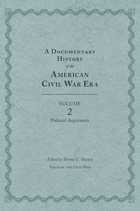
Volume 2 in the series, Political Arguments, presents the words of politicians, political party platforms, and administrative speeches. It is divided into two sections. The first, Voices of the Politicians and Political Parties, comprises the platforms of the major (and some minor) parties from1856 to 1876. Also included are such pieces as Robert E. Lee’s letter of resignation from the U.S. Army, a few key speeches by that rising politician from Illinois, Abraham Lincoln, and a letter on the “American Question” written by a European observer, Karl Marx. Other items include examples of the 1860–1861 state ordinances of secession and addresses on emancipation and Reconstruction by Jefferson Davis and by the Republican leader in the House of Representatives, Thaddeus Stevens.
Section two, Voices of the Administrations, contains records from the presidencies of James Buchanan, Abraham Lincoln, Andrew Johnson, Ulysses S. Grant, and Rutherford B. Hayes as well as a message from Confederate President Jefferson Davis telling his congress that the Southern cause was “just and holy.” Classic documents such as Lincoln’s announcement of forthcoming emancipation and the Emancipation Proclamation are here, as are lesser-known but important documents such as Francis Lieber’s 1863 revised law code for war, General Order 100, and Attorney General James Speed’s 1865 opinion supporting the Johnson administration’s decision to try the Lincoln murder conspirators by special military commission and not in the civilian courts.
Each of the selections in <i>Political Arguments<i> is preceded by editor Thomas Mackey’s introductory headnotes that explain the document’s historical significance and trace its lasting impact. These commentaries provide insight into not just law and public policy but also the broad sweep of issues important to Civil War– era Americans.
A Documentary History of the American Civil War Era is an essential acquisition for academic and public libraries in addition to being a valuable resource for courses on the War and Reconstruction, legal history, political history, and nineteenth- century American history.
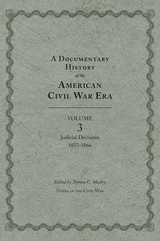
The first two volumes of the series, Legislative Achievements and Political Arguments, were released last year. The final installments, Judicial Decisions, is split into two volumes, with this one, volume 3, spanning from 1857 to 1866. It contains some of the classic judicial decisions of the time such as the 1857 decision in Dred Scott and the 1861 Ex parte Merryman decision. Other decisions are well known to specialists but deserve wider readership and discussion, such as the October 1859 Jefferson County, Virginia, indictment of John Brown and the decision in the 1864 case of political and seditious activity in Ex parte Vallandigham. These judicial voices constitute a lasting and often overlooked aspect of the age of Abraham Lincoln. Mackey’s headnotes and introductory essays situate cases within their historical context and trace their lasting significance. In contrast to the war, these judicial decisions lasted well past their immediate political and legal moment and deserve continued scholarship and scrutiny.
This document collection presents the raw “stuff” of the Civil War era so that students, scholars, and interested readers can measure and gauge how that generation met Lincoln’s challenge to “think anew, and act anew.” A Documentary History of the American Civil War Era is an essential acquisition for academic and public libraries in addition to being a valuable resource for courses on the Civil War and Reconstruction, legal history, political history, and nineteenth-century American history.
Thomas C. Mackey is a professor of history at the University of Louisville and adjunct Professor of Law at Brandeis School of Law. He is the author of Pornography on Trial and Pursuing Johns.
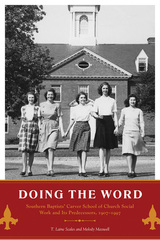

Montell organized his material according to the topics that dominated his tape-recorded conversations with residents of the area-farming, logging and rafting, steamboating, the Civil War-topics that the people themselves saw as important in their history. In reconstructing the past, the author also illuminates the relationship between geographic and economic factors in the region; the prolonged affects of a cataclysmic event, the Civil War, on the isolated area; and the impact of modernization, in the form of “hard” roads and cheap, TVA-supplied electricity, on the traditional ways of people.
First published in 1983, this book is now available in paperback for the first time. Included with this edition is a new foreword in which Montell and Mary Robbins, executive director of the Tennessee Upper Cumberland Tourism Association, describe changes in the area that have occured since the book’s initial appearance.
The Author: William Lynwood Montell, now retired, was coordinator of programs in folk and interculturual studies at Western Kentucky University. His numerous books include Ghosts along the Cumberland and The Saga of Coe Ridge.
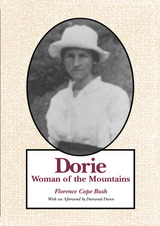
Dorie's story begins with her childhood on an isolated mountain farm, where we see first hand how her parents combined back-breaking labor with intense personal pride to produce everything their family needed—from food and clothing to tools and toys—from the land. Lumber companies began to invade the mountains, and Dorie's family took advantage of the financial opportunities offered by the lumber industry, not realizing that in giving up their lands they were also letting go of a way of life. Along with their machinery, the lumber companies brought in many young men, one of whom, Fred Cope, became Dorie's husband. After the lumber companies stripped the mountains of their timber, outsiders set the area aside as a national park, requiring Dorie, now married with a family of her own, to move outside of her beloved mountains.
Through Dorie's eyes, we see how the mountain farmers were forced to abandon their beloved rural life-style and customs and assimilate into cities like Knoxville, Tennessee. Her experiences were shared by hundreds of Appalachians during the early twentieth century. However, Dorie's perseverance, strength of character, and deep love of the Smokies make this a unique and moving narrative.
The Author: Florence Cope Bush is a former newspaper reporter and freelance writer in Knoxville, Tennessee. She is the author of Ocona Lufte Baptist—Pioneer Church of the Smokies, and a regular contributor to Smoky Mountain Historical Society publications.
Durwood Dunn is professor history at Tennessee Wesleyan College. He is author of Cades Cove: The Life and Death of a Southern Appalachian Community, 1818-1937.
READERS
Browse our collection.
PUBLISHERS
See BiblioVault's publisher services.
STUDENT SERVICES
Files for college accessibility offices.
UChicago Accessibility Resources
home | accessibility | search | about | contact us
BiblioVault ® 2001 - 2024
The University of Chicago Press









